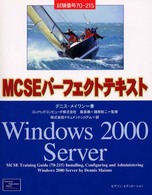Full Description
"The Parallel Curriculum Model (PCM) holds the power to help students and teachers 'see the whole' of what they are learning. We invite practitioners to read more about this model and join us on a professional journey that we believe will yield that joy and wisdom that comes from seeing the whole. To address the varying needs of teachers across the K-12 grade span—as well as different content areas—we decided to create a series of curriculum units, based on PCM, that could be used by practitioners. It is our hope that the lessons not only underscore important and discipline-specific content, but also illuminate the four parallels in unique and enduring ways."
—From the Introduction
Design exemplary language arts lessons based on the Parallel Curriculum Model!
Want to create rigorous learning opportunities for students in language arts based on a deeper understanding of pedagogy and curriculum design? As demonstrated in the best-selling book The Parallel Curriculum, the Parallel Curriculum Model (PCM) allows teachers to determine student performance levels and design intellectual challenges that help students develop expertise in specific subject areas.
Parallel Curriculum Units for Language Arts, Grades 6-12 provides sample language arts units written by practicing teachers to demonstrate what high-quality curriculum looks like within a PCM framework. Covering a variety of topics—including narrative voice, literary criticism, and writing original pieces—these field-tested units each contain:
Teacher rationales explaining the unit design
Connections to concepts, skills, and national or state standards
Step-by-step directions for delivering the lessons and unit
Modification strategies, assessments, and reproducibles
Use these examples to design your own units and deepen your understanding of how the PCM framework helps tailor curriculum to the abilities, interests, and learning preferences of each learner.
Contents
About the Editors
About the Contributors
Introduction to the Parallel Curriculum Model
1. Understanding and Finding Your Author's Voice: An Intermediate Language Arts Unit (Grades 6-7)
Introduction to the Unit - Lee-Ann Hayen
Content Framework - Judy Walsh
Assessments - Judy Walsh
Unit Sequence, Description, and Teacher Reflections
Lesson 1.1: The Contributors to Identity
Lesson 1.2: Shaping Your Voice
Lesson 1.3: The Influences on Mood
Lesson 1.4: Analyzing an Author's Voice
Lesson 1.5: Finding the Right Voice and Mood for Your Purpose
Lesson 1.6: Your Turn
2. The LIttle Napoleon in Us All: Literary Criticism and the Battle for Power (Grade 8)
Introduction to the Unit
Content Framework
Assessments
Unit Sequence, Description, and Teacher Reflections
Lesson 2.1: Preassessment/Brainstorming
Lesson 2.2: What Is Allegory?
Lesson 2.3: Diary of an Author
Lesson 2.4: Write a Personal Allegory
Lesson 2.5: Character Analysis, Part I
Lesson 2.6: Orwell's Responsibility
Lesson 2.7: Literary Criticism
Lesson 2.8: WRite a Literary Critique of Animal Farm
Lesson 2.9: Character Analysis Map, Part II
Lesson 2.10: What Is a Classic?
Lesson 2.11: Survivor: The Isms
Lesson 2.12: Final Assessment
3. Reacting to a Literary Model: Writing Original Pieces (Grades 9-10)
Introduction to the Unit
Content Framework
Assessments
Unit Sequence, Description, and Teacher Reflections
Lesson 3.1: Preassessment
Lessons 3.2 and 3.3: Setting and Mood
Lessons 3.4 and 3.5: Creating Realistic Characters
Lessons 3.6 and 3.7: Prejudice, Conflict, and Theme
Lesson 3.8: Postassessment
4. You Be the Critic: Understanding, Using, and Writing Literary Criticism (Grades 11-12)
Introduction to the Unit
Content Framework
Assessments
Unit Sequence, Description, and Teacher Reflections
Lesson 4.1: Introduction to Literary Criticism
Lesson 4.2: Analyzing a Fictional passage for Content
Lessons 4.3, 4.4, and 4.5: Character Development and Point of View
Lessons 4.6 and 4.7: Understanding Tone
Lessons 4.8 and 4.9: What Is Style?
Lesson 4.10: Recognizing Style
Lesson 4.11: Rhetoric and Rhetorical Devices
Lessons 4.12 and 4.13 The Persuasive Essay and the Editorial
Lessons 4.14 and 4.15: Writing a Literary Analysis
Index






